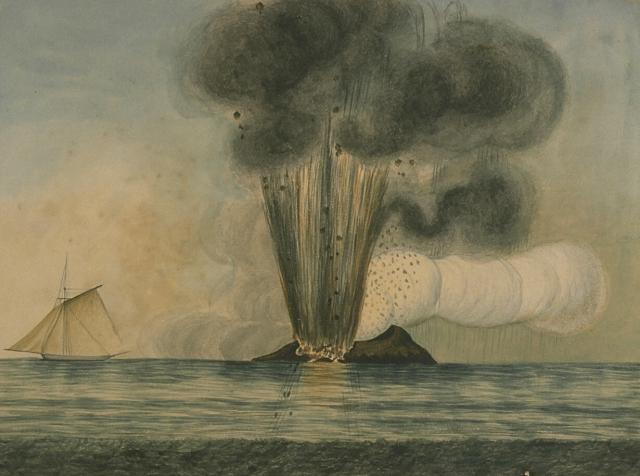 [Image: Temporary islands emerge from the sea, via].
[Image: Temporary islands emerge from the sea, via].
In the Mediterranean Sea southwest of Sicily, an island comes and goes. Called, alternately and among other names, depending on whose territorial interests are at stake, Graham Bank, Île Julia, the island of Ferdinandea, or, more extravagantly, a complex known as the Campi Flegrei del Mar di Sicilia (the Phlegraean Fields of the Sicily Sea), this geographic phenomenon is fueled by a range of submerged volcanoes. One peak, in particular, has been known to break the waves, forming a small, ephemeral island off the coast of Italy.
And, when it does, several nation-states are quick to claim it, including, in 1831, when the island appeared above water, “the navies of France, Britain, Spain, and Italy.” Unfortunately for them, it eroded away and disappeared beneath the waves in 1832.
It then promised to reappear, following new eruptions, in 2002 (but played coy, remaining 6 meters below the surface).
The island, though, always promises to show up again someday, potentially restarting old arguments of jurisdiction and sovereignty—is it French? Spanish? Italian? Maltese? perhaps a micronation?—so some groups are already well-prepared for its re-arrival. As Ted Nield explains in his book Supercontinent, “the two surviving relatives of Ferdinand II commissioned a plaque to be affixed to the then still submerged volcanic reef, claiming it for Italy should it ever rise again.” This is the impending geography of states-in-waiting, instant islands that, however temporarily, redraw the world’s maps.
The story of Ferdinandea, as recounted by that well-known primary historical source Wikipedia and seemingly ripe for inclusion in the excellent Borderlines blog by Frank Jacobs, is absolutely fascinating: it’s appeared on an ornamental coin, it was visited by Sir Walter Scott, it inspired a short story by James Fenimore Cooper, it was depth-charged by the U.S. military who mistook it for a Libyan submarine, and it remains the subject of active geographic speculation by professors of international relations. It is, in a sense, Europe’s Okinotori—and one can perhaps imagine some Borgesian wing of the Italian government hired to sit there in a boat, in open waters, for a whole generation, armed with the wizardry of surveying gear and a plumb bob dangling down into the sea, testing for seismic irregularities, as if casting a spell to coax this future extension of the Italian motherland up into the salty air.
